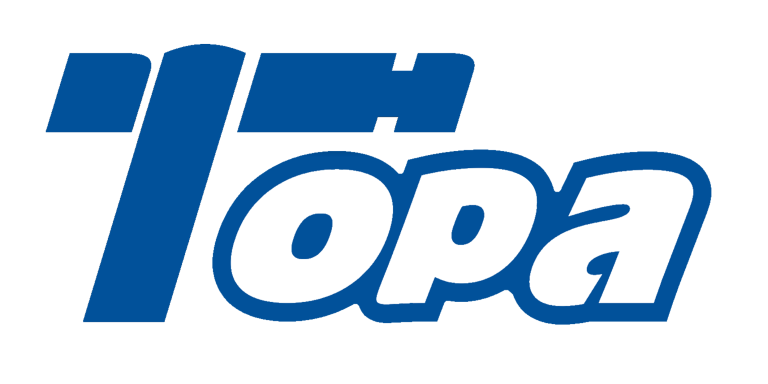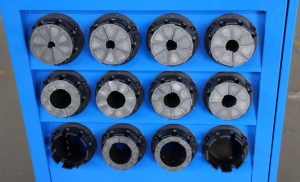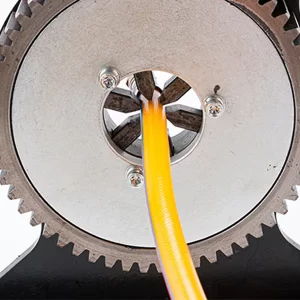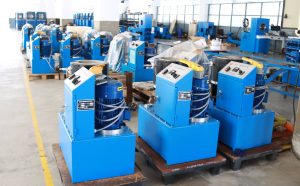Understanding the hidden expenses of hydraulic hose crimping equipment is vital for companies looking to manage costs effectively. This article, titled “What Are the Hidden Expenses of Hydraulic Hose Crimping Equipment?”, aims to uncover all the less obvious costs associated with owning and operating crimping machines. But here’s the kicker: beyond the initial purchase price, many factors influence total expenses, including maintenance, consumables, training, and downtime. Recognizing these elements helps businesses budget accurately, avoid surprises, and improve overall profitability. We will explore direct and indirect costs, maintenance, operator training, energy consumption, compliance, and more to provide a comprehensive view of what truly impacts your hydraulic hose crimping budget.
1. What are the direct costs involved in hydraulic hose crimping equipment?
Direct costs include the upfront purchase price of the crimper itself, installation fees, and the expense of initial training for operators. Additionally, consumables like dies and replacement parts represent ongoing direct expenditures. What’s the real story? While the equipment price grabs the spotlight, consumables can add up quickly. For example, a workshop purchasing multiple die sets for various hose sizes faced significant recurring costs. Another case involved installation complexities that increased initial expenses. Companies often underestimate the impact of training, which is crucial for safe and efficient operation. Investing upfront in comprehensive training reduces costly errors and downtime later. A detailed understanding of direct costs forms the foundation for effective financial planning.
| Direct Cost Element | Description | Typical Expense Range |
|---|---|---|
| Equipment Purchase | Crimper machine cost | $5,000 – $50,000+ |
| Installation | Setup and calibration | $500 – $3,000 |
| Operator Training | Initial staff training | $1,000 – $5,000 |
| Consumables | Dies, seals, fittings | $500 – $3,000 annually |
2. What hidden maintenance costs affect hydraulic hose crimping equipment?
Maintenance often represents the largest hidden expense. Regular servicing, part replacements, and unexpected repairs add up. Ready for the good part? Poor maintenance leads to premature wear and costly breakdowns. A factory that ignored scheduled maintenance saw repair costs soar 30% higher. Preventive care, including die inspection, lubrication, and hydraulic fluid changes, extends equipment life. Calibration services to maintain crimp accuracy also incur costs but reduce scrap and rework. Scheduling maintenance without disrupting production is a logistical challenge, sometimes requiring overtime labor. Recognizing and budgeting for these hidden maintenance costs protects your operation from expensive surprises.
| Maintenance Activity | Frequency | Cost Impact |
|---|---|---|
| Preventive Servicing | Quarterly or semi-annual | Moderate and planned |
| Part Replacements | As needed | Can be costly if delayed |
| Calibration | Annually or per shift | Ensures quality, moderate cost |
| Unexpected Repairs | Unscheduled | Potentially very expensive |
3. How do operator training and skill development contribute to hidden costs?
Training isn’t just a one-time expense. Ongoing skill development, certification, and retraining as equipment or software updates occur add hidden costs. This is where it gets interesting: insufficiently trained operators cause more errors, downtime, and material waste. A logistics company found that investing in continuous training reduced faulty crimps by 40%, improving overall efficiency. Training covers equipment operation, safety protocols, software interfaces, and inspection techniques. Ignoring this area increases hidden costs through rework and potential safety incidents. Structured, periodic training ensures consistent quality and reduces operational risk.
| Training Aspect | Description | Business Benefit |
|---|---|---|
| Initial Training | Equipment operation basics | Reduces early mistakes |
| Ongoing Development | Software updates and refreshers | Maintains skill relevance |
| Certification | Formal qualification programs | Assures competency |
4. What impact do consumables and accessories have on overall expenses?
Consumables like dies, seals, fittings, hydraulic fluids, and lubrication products represent recurring costs often overlooked. But here’s the kicker: frequent die wear requires replacement, directly affecting cost. An industrial service provider tracked die lifespan and found timely replacements improved crimp quality and reduced scrap. Upgrading tooling or adding customized accessories may increase upfront costs but boost productivity and precision. Budgeting for consumables requires understanding usage rates and supplier pricing trends. Proper handling and storage also extend consumable life, indirectly reducing expenses.
| Consumable Type | Replacement Frequency | Cost Consideration |
|---|---|---|
| Crimp Dies | After several hundred cycles | High cost but essential |
| Seals and Fittings | Per assembly or scheduled | Moderate cost |
| Hydraulic Fluids | Periodically | Necessary for smooth operation |
5. How does equipment depreciation influence the total cost of ownership?
Depreciation accounts for the reduction in equipment value over time, affecting financial planning and resale value. What’s the real story? A company factoring depreciation accurately set aside funds for future replacements, avoiding cash flow crunches. Typically, hydraulic hose crimpers depreciate over 5 to 10 years, depending on usage intensity. Depreciation also influences tax write-offs and budgeting. Companies that overlook depreciation risk underestimating long-term ownership costs, leading to financial surprises. Including depreciation in cost models offers a clearer picture of true equipment expenses.
| Depreciation Factor | Typical Lifespan | Financial Impact |
|---|---|---|
| Heavy Use | 3-5 years | Faster depreciation |
| Moderate Use | 5-7 years | Balanced depreciation |
| Light Use | 7-10 years | Slower depreciation |
6. What role do energy consumption and operational costs play?
Energy consumption is a continuous expense often underestimated. Crimping machines require electricity for hydraulic pumps, control systems, and auxiliary equipment. This is where it gets interesting: a production facility audited its energy use and identified 10% savings through energy-efficient upgrades and scheduling. Cooling systems and compressed air usage add to operational costs. Implementing energy management practices can reduce expenses significantly. Monitoring power consumption during idle periods and optimizing load cycles can lead to cost savings. Energy efficiency improvements directly enhance profitability.
| Energy Use Aspect | Description | Cost Saving Strategies |
|---|---|---|
| Hydraulic Pumps | Main power consumers | Use energy-efficient models |
| Control Systems | Electronic components | Power-saving modes |
| Auxiliary Systems | Cooling and air compressors | Scheduled use and upgrades |
7. How can poor equipment selection lead to hidden expenses?
Choosing inappropriate crimping equipment for specific applications results in higher maintenance, inefficiencies, and material waste. Ready for the good part? A company using underpowered crimpers for large hoses faced frequent failures and downtime. Conversely, oversized machines for small jobs waste energy and space. Selecting machines aligned with production volume, hose types, and future needs prevents unnecessary costs. Consulting experts and reviewing operational requirements before purchase minimizes hidden expenses. Equipment mismatches ripple into reduced throughput and increased labor costs.
| Equipment Type | Suitability | Hidden Cost Risks |
|---|---|---|
| Underpowered Machines | High-volume or large hoses | Frequent repairs and failures |
| Oversized Machines | Low-volume, small hoses | Energy waste and inefficiency |
8. What are the costs related to software and technology integration?
Integrating software for controls, data logging, and maintenance adds licensing fees, hardware upgrades, and training expenses. But here’s the kicker: these costs are investments that improve efficiency and quality. However, poor integration planning can lead to compatibility issues and extra IT support costs. A hydraulic assembly plant noted initial integration costs but recouped them with reduced downtime and defect rates. Vendor support and software updates may also carry fees. Planning for technology lifecycle expenses is crucial.
| Software Cost Element | Description | Cost Impact |
|---|---|---|
| Licensing Fees | Software use rights | Recurring annual or monthly |
| Hardware Upgrades | Interfaces and sensors | One-time investment |
| Training and Support | User education and troubleshooting | Ongoing expense |
9. How do quality control failures add to hidden costs?
Failures in quality control lead to scrap material, rework, and customer returns, all of which inflate expenses. What’s the real story? A workshop tracking defect-related costs realized that improving inspection reduced scrap by 25%, saving thousands annually. Repeated rework consumes labor and machine time, reducing capacity. Warranty claims and damaged reputation further increase costs. Investing in stringent quality control protocols and software reduces these hidden costs by catching defects early and ensuring product reliability.
| Quality Failure Type | Consequence | Cost Implication |
|---|---|---|
| Scrap Material | Wasted raw materials | Direct financial loss |
| Rework | Additional labor and time | Reduced throughput |
| Warranty Claims | Repairs and replacements | Customer dissatisfaction |
10. What are the logistical costs associated with hydraulic hose crimping equipment?
Shipping, handling, and storage of crimping equipment involve expenses often overlooked in initial budgeting. This is where it gets interesting: large machines require specialized transport and installation, which can cost thousands. Proper storage conditions to prevent damage add to facility expenses. Relocating equipment within or between sites also generates costs. A company relocating its crimping line budgeted extensively for logistics, preventing surprises. Planning and consolidating shipments reduce these costs.
| Logistical Cost | Description | Typical Cost Range |
|---|---|---|
| Shipping | Transport from manufacturer | $500 – $5,000+ |
| Handling | Loading/unloading labor | Variable |
| Storage | Warehouse space and protection | Ongoing operational cost |
11. How do safety and compliance impact hidden costs?
Meeting safety regulations requires investment in protective equipment, training, and audits. Non-compliance can lead to fines and operational halts. Ready for the good part? A company investing in regular safety training and compliance audits avoided costly OSHA penalties. Compliance also boosts employee confidence and reduces accident-related costs. Safety management integrates with maintenance and quality control, forming part of the total cost structure that companies must consider.
| Safety Aspect | Requirement | Financial Impact |
|---|---|---|
| PPE Provision | Personal protective gear | Initial and replacement costs |
| Training | Regular safety education | Resource allocation |
| Compliance Audits | Regulatory inspections | Avoid fines and shutdowns |
12. What are the costs of environmental management and waste disposal?
Proper disposal of hazardous materials like hydraulic fluids and used parts is required by law and adds costs. But here’s the kicker: improper handling risks fines and reputational damage. Companies must budget for waste collection, treatment, and recycling. Environmental management programs may also require investment in equipment and staff training. Some firms reduced costs by partnering with certified disposal services and implementing recycling initiatives.
| Environmental Cost | Description | Typical Expense |
|---|---|---|
| Hazardous Waste | Fluid and contaminated parts | Disposal fees |
| Recycling Programs | Material recovery efforts | Potential cost offsets |
| Staff Training | Environmental compliance | Ongoing operational cost |
13. How do downtime and productivity losses factor into hidden expenses?
Machine breakdowns cause lost production hours and can require overtime or backup equipment, increasing labor costs. What’s the real story? A company calculated that every hour of crimper downtime cost over $1,000 in lost output. Proactive maintenance and quality control reduce unexpected downtime. Scheduling backups and cross-training employees also mitigate losses. Recognizing downtime as a hidden expense emphasizes the importance of reliability-focused investments.
| Downtime Cause | Effect | Cost Implication |
|---|---|---|
| Mechanical Failure | Production halt | Lost revenue and labor costs |
| Quality Rejections | Rework and delays | Increased operational costs |
| Scheduled Maintenance | Planned downtime | Opportunity cost |
14. What are the indirect costs related to supplier and vendor relationships?
Negotiating contracts, managing supplier quality, and handling lead times introduce indirect costs. This is where it gets interesting: unreliable suppliers cause production delays and increase inventory costs. Building strong vendor relationships reduces these hidden expenses. Some companies use vendor-managed inventory to streamline supplies and reduce overhead. Contract terms and service agreements also affect total costs, influencing risk and flexibility.
| Supplier Cost Aspect | Description | Impact |
|---|---|---|
| Contract Negotiation | Time and legal resources | Administrative expenses |
| Quality Variance | Supplier product inconsistency | Production disruption |
| Lead Time Management | Inventory holding costs | Cash flow impact |
15. How can companies effectively manage and reduce hidden costs?
Regular cost audits, preventive maintenance, operator training, and smart technology investments help control hidden expenses. Ready for the good part? A hydraulic assembly plant that implemented quarterly audits identified cost-saving opportunities worth 15% of their budget. Investing in operator skills reduced errors, while maintenance programs cut repair bills. Technology upgrades improve efficiency and data visibility. Comprehensive management strategies empower companies to optimize costs without compromising quality or safety.
| Cost Management Strategy | Description | Benefit |
|---|---|---|
| Cost Audits | Regular financial reviews | Identifies waste and savings |
| Preventive Maintenance | Scheduled servicing | Reduces costly breakdowns |
| Training Investments | Skill development | Enhances productivity |
FAQ Section
Q1: What is the total cost of ownership for hydraulic hose crimping equipment?
It includes purchase, maintenance, consumables, training, and indirect expenses.
Q2: How do maintenance costs affect equipment expenses?
Unexpected repairs and routine servicing can significantly increase costs.
Q3: What hidden costs arise from poor operator training?
Errors, rework, and inefficiencies lead to added expenses.
Q4: Why is equipment depreciation important in cost analysis?
It affects budgeting and impacts resale value and write-offs.
Q5: How can companies reduce hidden costs effectively?
Through preventive maintenance, cost audits, and investing in training and technology.




